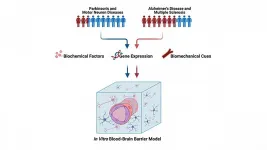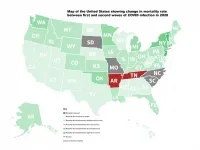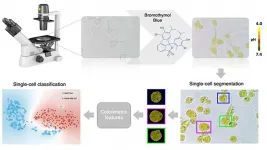Crying human tear glands grown in the lab
2021-03-16
(Press-News.org) Researchers from the lab of Hans Clevers (Hubrecht Institute) and the UMC Utrecht used organoid technology to grow miniature human tear glands that actually cry. The organoids serve as a model to study how certain cells in the human tear gland produce tears or fail to do so. Scientists everywhere can use the model to identify new treatment options for patients with tear gland disorders, such as dry eye disease. Hopefully in the future, the organoids can even be transplanted into patients with non-functioning tear glands. The results will be published in Cell Stem Cell on the 16th of March.
The tear gland is located in the upper part of the eye socket. It secretes tear fluid, which is essential for lubrication and nutrition of the cornea and has antibacterial components. Rachel Kalmann (UMCU), ophthalmologist and researcher on the project, explains: "Dysfunction of the tear gland, for example in Sjögren's syndrome, can have serious consequences including dryness of the eye or even ulceration of the cornea. This can, in severe cases, lead to blindness." However, the exact biology behind the functioning of the tear gland was unknown and a reliable model to study it was lacking. That is, until now: researchers from the group of Hans Clevers (Hubrecht Institute) present the first human model to study how the cells in the tear gland cry and what can go wrong.
Crying organoids
The researchers used organoid technology to grow miniature versions of the mouse and human tear gland in a dish. These so-called organoids are tiny 3D-structures that mimic the function of actual organs. After they cultivated these tear gland organoids, the challenge was to get them to cry. Marie Bannier-Hélaouët, researcher on the project, explains: "Organoids are grown using a cocktail of growth-stimulating factors. We had to modify the usual cocktail to make the organoids capable of crying." Once the researchers found the right mixture of growth factors, they could induce the organoids to cry. "Our eyes are always wet, as are the tear glands in a dish," Bannier-Hélaouët says.
Swelling up like a balloon
Similar to the way people cry in response to for example pain, the organoids cry in response to chemical stimuli such as noradrenaline. The cells of the organoids shed their tears on the inside of the organoid, which is called the lumen. As a result, the organoid will swell up like a balloon. The size of the organoids can therefore be used as an indicator of tear production and
-secretion. "Further experiments revealed that different cells in the tear gland make different components of tears. And these cells respond differently to tear-inducing stimuli," says Yorick Post, another researcher on the project.
Atlas of cells
The tear gland is composed of several cell types, but the current model only captures one, the ductal cell. In their paper, the researchers present an atlas of the cells in the tear gland to demonstrate their differences. They generated this atlas using single-cell sequencing; a method with which individual cells can be examined and characterized. Post explains: "In the future, we would like to also grow the other tear gland cell type, so-called acinar cell, in a dish. That way, we can eventually grow a full tear gland in the lab." With the atlas, the researchers were also able to identify new tear products, which help protect the eye from infections.
Transplanting organoids
The development of the miniature tear glands holds promise for patients suffering from tear gland disorders. Scientists everywhere can use the model to identify new drugs for patients who do not produce enough tears. Additionally, the organoids can be used to study how cancers of the tear gland form and may be treated. "And hopefully in the future, this type of organoids may even be transplantable to patients with non-functioning tear glands," Bannier-Hélaouët concludes. The study demonstrates once more the broad potential of organoid technology for science and medicine.
INFORMATION:
Publication
Marie Bannier-Hélaouët, Yorick Post, Jeroen Korving, Marc Trani Bustos, Helmuth Gehart, Harry Begthel, Yotam E. Bar-Ephraim, Jelte van der Vaart, Rachel Kalmann, Saskia M. Imhof and Hans Clevers. Exploring the human lacrimal gland using organoids and single-cell sequencing. Cell Stem Cell (2021).
Hans Clevers is group leader at the Hubrecht Institute and the Princess Máxima Center for Pediatric Oncology, professor of Molecular Genetics at Utrecht University, and Oncode Investigator.
About the Hubrecht Institute
The Hubrecht Institute is a research institute focused on developmental and stem cell biology. It encompasses 21 research groups that perform fundamental and multidisciplinary research, both in healthy systems and disease models. The Hubrecht Institute is a research institute of the Royal Netherlands Academy of Arts and Sciences (KNAW), situated on Utrecht Science Park. Since 2008, the institute is affiliated with the UMC Utrecht, advancing the translation of research to the clinic. The Hubrecht Institute has a partnership with the European Molecular Biology Laboratory (EMBL). For more information, visit http://www.hubrecht.eu.
ELSE PRESS RELEASES FROM THIS DATE:
2021-03-16
Like a well-trained soldier, a white blood cell uses specialized abilities to identify and ultimately destroy dangerous intruders, including creating a protrusion to effectively reach out, lock-on, probe, and possibly attack its prey. Researchers reporting March 16 in Biophysical Journal show in detail that these cells take seconds to morph into these highly rigid and viscous defensive units.
Senior author Julien Husson (@_julienhusson), a biophysicist at École Polytechnique near Paris, and collaborators showed previously that certain white blood cells, called T cells, ...
2021-03-16
WASHINGTON, March 16, 2021 -- Men and women are impacted differently by brain diseases, like Alzheimer's disease and Parkinson's disease. Researchers are urging their colleagues to remember those differences when researching treatments and cures.
In APL Bioengineering, by AIP Publishing, University of Maryland scientists highlight a growing body of research suggesting sex differences play roles in how patients respond to brain diseases, as well as multiple sclerosis, motor neuron disease, and other brain ailments.
That is progress from just a few years ago, said Alisa Morss ...
2021-03-16
Stem-cell-derived organoids that swell up with tears could shed light on the biology of crying and dry-eye disease, suggests a study publishing March 16 in the journal Cell Stem Cell. Although regenerative therapies using human tear-gland organoids will not be possible anytime soon, these researchers have demonstrated that the organoids can engraft, integrate, and produce mature tear products upon transplantation into mouse tear glands.
"We hope that scientists will use our model to identify new treatment options for patients with tear-gland disorders by either testing new drugs on a patient's organoids or expanding healthy cells and, one day, using them for transplantation," says senior study author Hans Clevers (@HansClevers) of the Hubrecht Institute.
The ...
2021-03-16
Wealthier northeastern US states and Western European countries tended to have significantly lower mortality rates during second-wave COVID-19 infections, new research from the University of Sydney and Tsinghua University has shown. However, the pattern was not as general as expected, with notable exceptions to this trend in Sweden and Germany.
Researchers say mortality change could have several explanations:
European first-wave case counts were underestimated;
First-wave deaths disproportionately affected the elderly;
Second-wave infections tended to affect younger people;
With some ...
2021-03-16
WASHINGTON, March 16, 2021 -- Cancerous cells exhibit several key differences from healthy cells that help identify them as dangerous. For instance, the pH -- the level of acidity -- within a cancerous cell is not the same as the pH within a healthy cell.
Researchers from the National University of Singapore developed a method of using machine learning to determine whether a single cell is cancerous by detecting its pH. They describe their work in the journal APL Bioengineering, from AIP Publishing.
"The ability to identify single cells has acquired a paramount importance in the field of precision and personalized medicine," ...
2021-03-16
What The Study Did: The findings of this study suggest that, based on a sample from an otherwise healthy population, the overall number of SARS-CoV-2 infections in the U.S. may be substantially higher than estimates based on public health case reporting.
Authors: Robert L. Stout, Ph.D., of Clinical Reference Laboratory Inc. in Lenexa, Kansas, is the corresponding author.
To access the embargoed study: Visit our For The Media website at this link https://media.jamanetwork.com/
(doi:10.1001/jamanetworkopen.2021.1552)
Editor's Note: The article includes conflict of interest and funding/support disclosures. Please see the article for additional information, including other authors, author contributions and affiliations, ...
2021-03-16
What The Study Did: Researchers examined nursing homes in communities with the highest COVID-19 prevalence to identify characteristics associated with resident infection rates.
Authors: Hye-Young Jung, Ph.D., of Weill Cornell Medical College in New York, is the corresponding author.
To access the embargoed study: Visit our For The Media website at this link https://media.jamanetwork.com/
(doi:10.1001/jamanetworkopen.2021.1555)
Editor's Note: The article includes funding/support disclosures. Please see the article for additional information, including ...
2021-03-16
The first systematic study of its kind describes how human viruses including SARS-CoV-2 are better adapted to infecting certain types of tissues based on their ability to hijack cellular machinery and protein synthesis.
Carried out by researchers at the Centre for Genomic Regulation (CRG), the findings could help the design of more effective antiviral treatments, gene therapies and vaccines. The study is published today in the journal Cell Reports.
Living organisms make proteins inside their cells. Each protein consists of single units of amino acids which are stitched together according to instructions encoded within DNA. The basic units of these instructions are known as a codons, each of which corresponds ...
2021-03-16
When scientists at the Institute of Science and Technology (IST) Austria looked at developing zebrafish embryos, they observed an abrupt and dramatic change: within just a few minutes, the solid-like embryonic tissue becomes fluid-like. What could cause this change and, what is its role in the further development of the embryo? In a multidisciplinary study published in the journal Cell, they found answers that could change how we look at key processes in development and disease, such as tumor metastasis.
To learn more about how a tiny bunch of cells develops into complex systems ...
2021-03-16
CAMBRIDGE, MA -- In the past few years, several medications have been found to be contaminated with NDMA, a probable carcinogen. This chemical, which has also been found at Superfund sites and in some cases has spread to drinking water supplies, causes DNA damage that can lead to cancer.
MIT researchers have now discovered a mechanism that helps explain whether this damage will lead to cancer in mice: The key is the way cellular DNA repair systems respond. The team found that too little activity of one enzyme necessary for DNA repair leads to much higher cancer rates, while too much activity can produce tissue damage, especially in the liver, which can be fatal.
Activity ...
LAST 30 PRESS RELEASES:
[Press-News.org] Crying human tear glands grown in the lab



